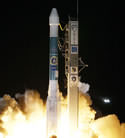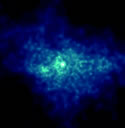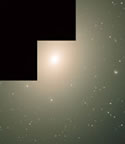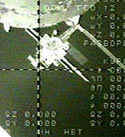
Image credit: NASA
NASA’s Comet Nucleus Tour (CONTOUR) spacecraft launched successfully on board a Boeing Delta II rocket this week. Designed by the John Hopkins University Applied Physics Laboratory, the 970 kilogram spacecraft was placed into an elliptical orbit 63 minutes after launch. CONTOUR will orbit Earth until August 15, when it will fire its main engine and begin chasing Comets Encke and Schwassmann-Wachmann 3. If all goes as planned, the spacecraft will get as close as 100km from each comet’s nucleus.
NASA?s Comet Nucleus Tour (CONTOUR) spacecraft ? set to provide the closest look yet at the ?heart? of a comet?successfully launched today at 2:47 a.m. EDT aboard a Boeing Delta II rocket from Cape Canaveral Air Force Station, Fla.
Designed and built by The Johns Hopkins University Applied Physics Laboratory (APL) in Laurel, Md., the 2,138-pound (970-kilogram) spacecraft was placed into an elliptical Earth orbit 63 minutes after launch. About 19 minutes later the mission operations team at APL acquired a signal from the spacecraft through the Deep Space Network antenna station in Goldstone, Calif., and by 5:45 a.m. EDT Mission Director Dr. Robert W. Farquhar of the Applied Physics Lab confirmed the craft was operating normally and ready to carry out its early orbit maneuvers.
?CONTOUR?s launch was a spectacular start to an important project,? says Dr. Stamatios M. Krimigis, head of the APL Space Department. ?CONTOUR is next in the growing lineup of missions to explore small planetary bodies ? such as comets and asteroids ? and we expect it will add much to what little we know about these ancient samples of the solar system?s original materials.?
CONTOUR will orbit Earth until Aug. 15, when it?s scheduled to fire its main engine and enter a comet-chasing orbit around the sun. The mission?s flexible four-year plan includes encounters with comets Encke (Nov. 12, 2003) and Schwassmann-Wachmann 3 (June 19, 2006), though it can add an encounter with a ?new? and scientifically valuable comet from the outer solar system, should one be discovered in time for CONTOUR to fly past it. CONTOUR?s four scientific instruments will take detailed pictures and measure the chemical makeup of each comet?s nucleus ? a chunk of ice and rock ? while analyzing the surrounding gas and dust.
The 8-sided solar-powered craft will fly as close as 62 miles (100 kilometers) from each nucleus, protected by a 10-inch-thick, layered dust shield of heavy Nextel and Kevlar fabric. Scientists expect the data to reveal the differences between comet nuclei and answer questions about the role comets had in shaping the Earth and other planets.
?We?re looking forward to a fantastic mission,? says APL?s Edward L. Reynolds, who at launch assumed the role of CONTOUR project manager from Mary C. Chiu, who is retiring from the Applied Physics Laboratory. ?From mission design and operations at APL, to the navigation group at NASA?s Jet Propulsion Laboratory, to the science effort headed by Cornell University, this team includes the talent and expertise needed to capture and deliver the best data yet on a comet?s nucleus.?
The $159 million CONTOUR is the sixth mission in NASA?s Discovery Program of lower cost, scientifically focused exploration projects. APL manages the mission, built the spacecraft and its two cameras, and will operate CONTOUR during flight. NASA?s Goddard Space Flight Center, Greenbelt, Md., provided CONTOUR?s neutral gas/ion mass spectrometer and von Hoerner & Sulger, GmbH, Schwetzingen, Germany, built the dust analyzer. NASA?s Jet Propulsion Laboratory, Pasadena, Calif., will provide navigation and Deep Space Network (DSN) support. Dr. Joseph Veverka, CONTOUR?s principal investigator from Cornell University, Ithaca, N.Y., leads a science team of co-investigators from universities, industry and government agencies in the U.S. and Europe.
Original Source: NASA News Release




